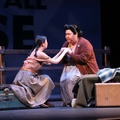Part 6 >>
Amano and the others stepped off the train at Pennsylvania Station on June 16. Guards escorted the group across the street to the Pennsylvania Hotel, onto a freight elevator and up to the fourth floor. They joined “about thirty other people quartered in rooms close to us. Most of them looked like they had been living in New York. Among them were four or five Japanese ladies and, considering the circumstances, it was a very pleasant surprise to see them.” The pleasantries ended abruptly with a body and possession search:
This time, the F.B.I. was involved along with police in the search. When they checked my duffle bag that contained all of my possessions, they discovered a small sheet of paper among them. The police inquired, ‘What is this?’ ‘This is a list of the family addresses of my fellow prisoners,’ I replied. Without a word, he moved to confiscate it. I protested loudly. ‘Give it back to me! I need it. It contains no harmful or secret information.’ That was my answer. He glared at me and said, ‘anything written down must be confiscated,’ and with that, he snatched the paper and left. However, I had suspected that something like this would happen so I had made a duplicate copy. The day before leaving camp, even though very busy, I took the time to copy all the addresses on an inside lining of a cigarette pack. I had practiced how to write minute kanji (Chinese characters) so that they would appear as a single line. I wrote about 2900 kanji on a piece of paper that was small enough to fit in the palm of my hand. The policeman must have thought that he had done a good job finding that list of addresses so he checked no further. Because of his negligence, I was able to retain a list of the Panama and Hawaii groups’ family addresses in Japan.
Amano was not done resisting. He boarded the Gripsholm on June 18, angrily tearing off his “#203” badge. The ship carried, by Amano’s count, a total of 1,065 civilians, including Japanese ambassadors Kichisaburo Nomura and Saburo Kurusu, consulate employees, diplomats from the United States, Canada and Latin America, and exchange students from Thailand. The ship stopped in Rio de Janeiro on July 2, 1942 to pick up 383 Japanese nationals from Brazil and Paraguay.
The passengers resumed some normal activities, attending Spanish lessons and evening lectures on a variety of subjects. Again, the most popular events were the talent shows that brought the Japanese Latin American prisoners together. Groups detained at different locations, such as Camp Missoula, Camp Upton, and Camp Kenedy performed songs sung to the tune of traditional Japanese folk songs. The songs helped lift prisoners’ spirits with lyrics that were in turn playful (“when you open an umbrella shop, try Upton, the tents leak there”), angry (“the River Styx in hell is a child’s playground, picking up stones in Missoula is men’s hell”), and philosophical (“pretense is worthless, here, it’s a man’s world, meditation is a must, earthly things, let go”).
As the Gripsholm neared Lourenzo Marques (now Maputo), Mozambique, site of the first prisoner exchange with Americans on board the Asama Maru and the Conte Verde, a powerful sense of nationalism arose. Amano described the scene on July 22, 1942:
On the morning of the 22nd, all of us anxiously awaited the arrival of our Asama Maru and Conte Verde and a chance to see them proudly sail into the bay. It was a magnificent sight. The Hinomaru (Japanese flag) and a white cross were painted on the sides of the ships. High on the masts fluttered the Hinomaru and the sight of it against the tropical blue sky nearly blinded me. We breathlessly watched in anticipation. When the two ships drew alongside the Gripsholm, there arose a loud “banzai!” At that moment, the power of Imperial Japan seemed overwhelming.
Amano’s arrival in Singapore, renamed Shonan under Japanese occupation, signaled the end of his ordeal. He described how the Asama Maru and Conte Verde “plowed through the tropical blue ocean like two young stallions galloping ahead and leaving a beautiful double wake behind” as they entered Shonan Harbor.
Yoshitaro Amano ended his memoir ready to start anew. In closing, he wrote, “when I thought about the more than 180 days enduring the hardships and boredom in the concentration camps, it all seemed to disappear like bubbles floating away in the wind.”
© 2010 Esther Newman





